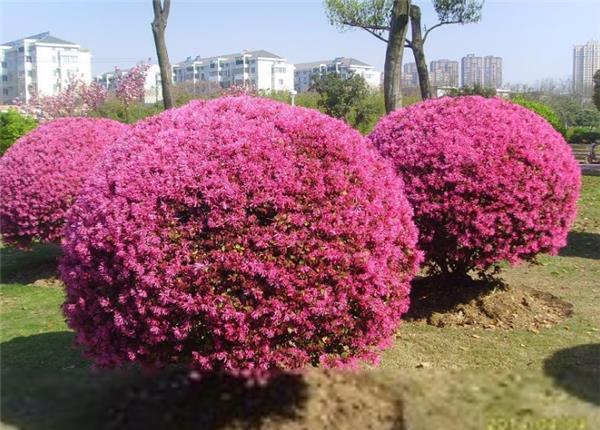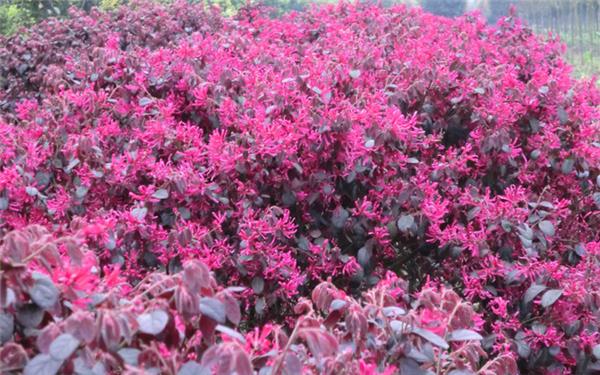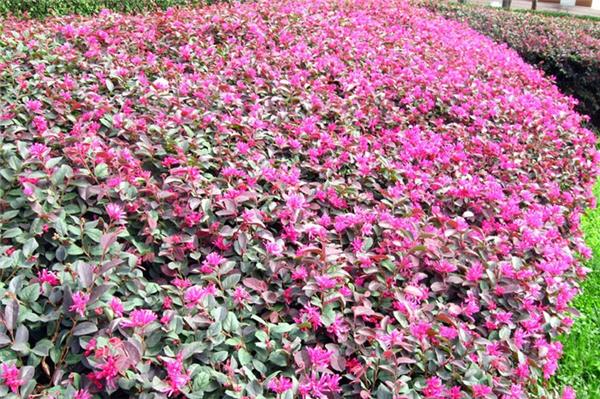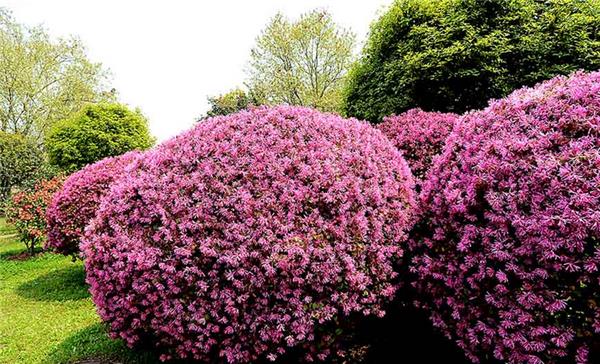Introduction and culture skills of Hongyun Hongji wood on the horizon
Hongjimu is a beautiful tree, its color is bright red, in summer and autumn, very conspicuous and beautiful, now, let's take a look at the knowledge of Hongjimu.

I. introduction of Hongjimu
Red sequoia bark dark gray or light grayish brown, much branched. Twigs reddish brown, densely stellate hairy. Leaves leathery alternate, ovoid or elliptic, long 2~5cm, apex mucronate, base round and oblique, asymmetric, stellate hairs on both sides, entire, dark red. 4 petals, purplish red linear long 1~2cm, 3-8 flowers clustered at the end of the branchlet. Capsule brown, subovate. The florescence is from April to May, the florescence is long, about 30-40 days, and it can blossom again on National Day. There are 3-8 flowers clustered on the peduncle in a terminal head, purplish red. The fruit period is August. Mainly distributed in the middle and lower reaches of the Yangtze River and the south, northern India. Flowers, roots and leaves can be used medicinally.

Second, the culture method of Red Timber.
Pot planting method and management
1. Upper basin
The seedlings propagated in the nursery and the stumps cultivated in the open field are transplanted into flowerpots, which are called upper pots. The specific measures are as follows: according to the height, crown width and root distribution of different grades of seedlings or stumps, select flowerpots of appropriate specifications, cover both sides of the basin bottom drainage hole with two tiles of suitable size (not completely cover the orifice), and then cover the orifice with a large tile to cover the degree of the orifice, or cover the drainage hole with three tiles in the shape of imbricate. When filling the soil, first put the sifted coarse particles on the bottom of the pot, and then add the culture soil; fill to 1 / 3 of the basin height, you can begin to move the seedlings, if the bare roots are transplanted, the center of the pot soil is in the shape of steamed buns, so that the roots are stretched downward and not curled; when the culture soil is about 3.5 meters away from the edge of the pot, you can gently shake the flowerpot and sink the soil, and gently press the pot soil on both sides of the seedling with your hands to keep the seedling in a straight posture. After moving into the greenhouse, the pot soil is watered with a fine-hole sprinkler to make the soil closely connect with the root group. before the new root occurs, do not shake the flowerpot at will, so as not to affect the rooting.

2. Change the basin
The operation of changing a potted plant to another pot is called changing the pot. Generally, there are two different situations in changing the basin: first, with the growth of the seedlings, the root group has no room to stretch in the basin soil, thus the growth is limited, and some roots often pass through or expose the ground through the drainage hole, so it should be changed from a small basin to a large basin. Secondly, the fully grown plants do not need to replace large flowerpots, just because after years of cultivation, the original pot soil, after the selective absorption of plants, remains a large number of toxic substances (trioxides), so that the physical and chemical properties of the soil become bad. the whole basin soil is full of old roots, at this time, the change of the pot is only to repair the root system, when changing the pot, only the new culture soil, the basin can not be changed.
In addition, when from a small basin to a large basin, it should be gradually changed to a larger basin according to the size of plant shape development, not to a large basin at once. Because this is not only labor-consuming and material-consuming, the cost is high, but also the water is not easy to adjust, the root of the plant is not ventilated well, the growth is not full, even overgrowth occurs, the bud formation is delayed, and the flowering rate is also low. Greenhouse flowers grow rapidly, generally changing pots 2 or 3 times before flowering. A large number of pot changes can make the plant strong, the growth is full, the plant height becomes lower and the plant shape is compact, but it will delay flowering, and the last change of pot before flowering is called planting. The safflower, wood potted flower and bonsai can be changed every 3 years. If there is a special need, you can change the pot or add a set of pots at any time to improve the ornamental value. Separate the fingers of the left hand when changing the basin, press on the base of the basin plant, lift the basin upside down, gently buckle the edge of the basin with the right hand, and the basin soil can be taken out. If it is not easy to take out, the iron bar can be used to pry gently around the basin, then turn the basin sideways, use the iron hammer to move the tiles on the drainage hole, and then invert the flowerpot as before, and the pot soil can be supported by the root. After the potted soil is taken out, part of the original soil of the plant should be scraped off, and too many old roots, withered roots and pan qu roots should be cut off, but the crisscross roots on the bonsai surface should remain in their original state and should not be sparse, otherwise it will damage the ornamental value of vigorous and simple.

3. Turn the basin
The purpose of turning the pot is to adjust the light of potted flowers in the greenhouse and to control and balance the growth potential of the whole plant. In one-sided greenhouse or inequality greenhouse, most of the light comes in from the south, so the potted flowers placed in the greenhouse, such as too long, often grow due to phototaxis. Plants tend to put light in the direction. The degree and speed of this deviation have an important relationship with the growth rate of plants, and the potted flowers with fast growth speed are also inclined. In order to prevent the inclined growth of potted flowers and destroy the original symmetrical and round shape of plants, the direction of flowerpots should be changed at intervals of a certain number of days, so that plants tend to develop normally. For the flowerpot placed in the open field, the phenomenon of phototaxis growth is not obvious, the regular conversion of the flowerpot is mainly to prevent the plant root from the drainage hole into the ground to grow, and the root protruding out of the pot will be broken when the flowerpot is moved for too long, affecting the normal growth of the potted flower.
4. Loose basin soil
Loosening basin soil can loosen the soil hardened by continuous watering, which is conducive to gas exchange and plant growth, and can also remove moss and weeds from the basin. The formation of moss affects the circulation of air on the basin surface, which is not conducive to the growth of plants. Once the basin surface is covered with moss, it is difficult to distinguish the wetting condition of the basin soil, and it is not convenient to water it at the right time. But some people think that moss can predict the dry and wet state of the basin soil, moss yellow lack of water, green moss has water, but also can retain water and increase the beauty of bonsai. Loosening the soil is an objective need, and it is better to remove the moss from the small and medium-sized potted flowers. Loosen the soil with iron or bamboo, gently move the topsoil, do not pry the whole plant, to prevent root injury caused by wilting.
5. Fertilization
Base fertilizer is often applied on the basin or changing the basin, and topdressing is applied during the growth period.
The above is the knowledge of Hongjimu. I hope I can help you.
Plants are biased towards the direction of light input. The degree and speed of this deviation have an important relationship with the growth rate of plants, and the potted flowers with fast growth speed are also inclined. In order to prevent the inclined growth of potted flowers and destroy the original symmetrical and round shape of plants, the direction of flowerpots should be changed at intervals of a certain number of days, so that plants tend to develop normally. For the flowerpot placed in the open field, the phenomenon of phototaxis growth is not obvious, the regular conversion of the flowerpot is mainly to prevent the plant root from the drainage hole into the ground to grow, and the root protruding out of the pot will be broken when the flowerpot is moved for too long, affecting the normal growth of the potted flower.
4. Loose basin soil
Loosening basin soil can loosen the soil hardened by continuous watering, which is conducive to gas exchange and plant growth, and can also remove moss and weeds from the basin. The formation of moss affects the circulation of air on the basin surface, which is not conducive to the growth of plants. Once the basin surface is covered with moss, it is difficult to distinguish the wetting condition of the basin soil, and it is not convenient to water it at the right time. But some people think that moss can predict the dry and wet state of the basin soil, moss yellow lack of water, green moss has water, but also can retain water and increase the beauty of bonsai. Loosening the soil is an objective need, and it is better to remove the moss from the small and medium-sized potted flowers. Loosen the soil with iron or bamboo, gently move the topsoil, do not pry the whole plant, to prevent root injury caused by wilting.
5. Fertilization
Base fertilizer is often applied on the basin or changing the basin, and topdressing is applied during the growth period.
The above is the knowledge of Hongjimu. I hope I can help you.
- Prev

Introduction of Phyllostachys pubescens from jade coral how to cultivate beautiful Phyllostachys pubescens
Introduction of Phyllostachys pubescens from jade coral how to cultivate beautiful Phyllostachys pubescens
- Next

Introduction to the method of putting Green plants in Home with the right philosophy of Life
Introduction to the method of putting Green plants in Home with the right philosophy of Life
Related
- Wuhan Hospital Iron Tree Blooming Result Was Instantly Frightened by the Gardener Master
- Which variety of camellia is the most fragrant and best? Which one do you like best?
- What is the small blue coat, the breeding methods and matters needing attention of the succulent plant
- Dormancy time and maintenance management of succulent plants during dormancy
- Minas succulent how to raise, Minas succulent plant pictures
- What are the varieties of winter succulent plants
- How to raise succulent plants in twelve rolls? let's take a look at some experience of breeding twelve rolls.
- Attention should be paid to water control for succulent plants during dormant period (winter and summer)
- Watering experience of twelve rolls of succulent plants
- Techniques for fertilizing succulent plants. An article will let you know how to fertilize succulent plants.

